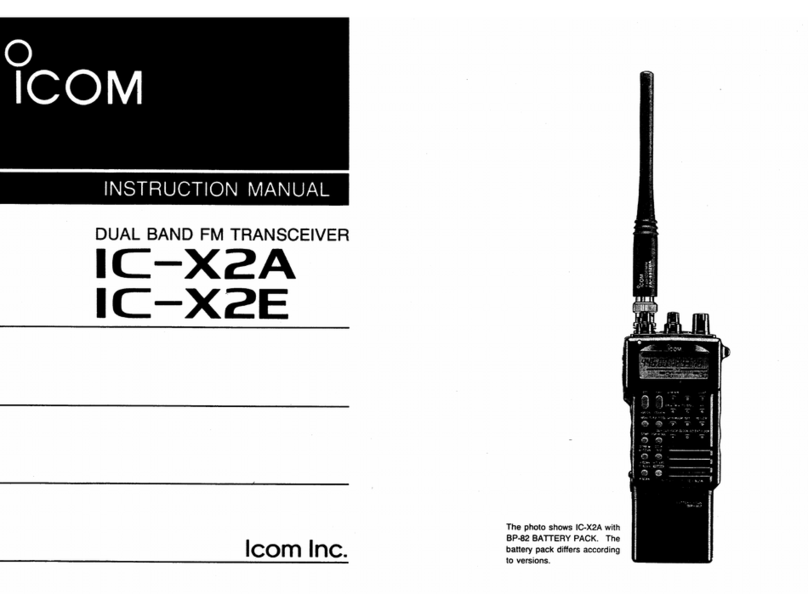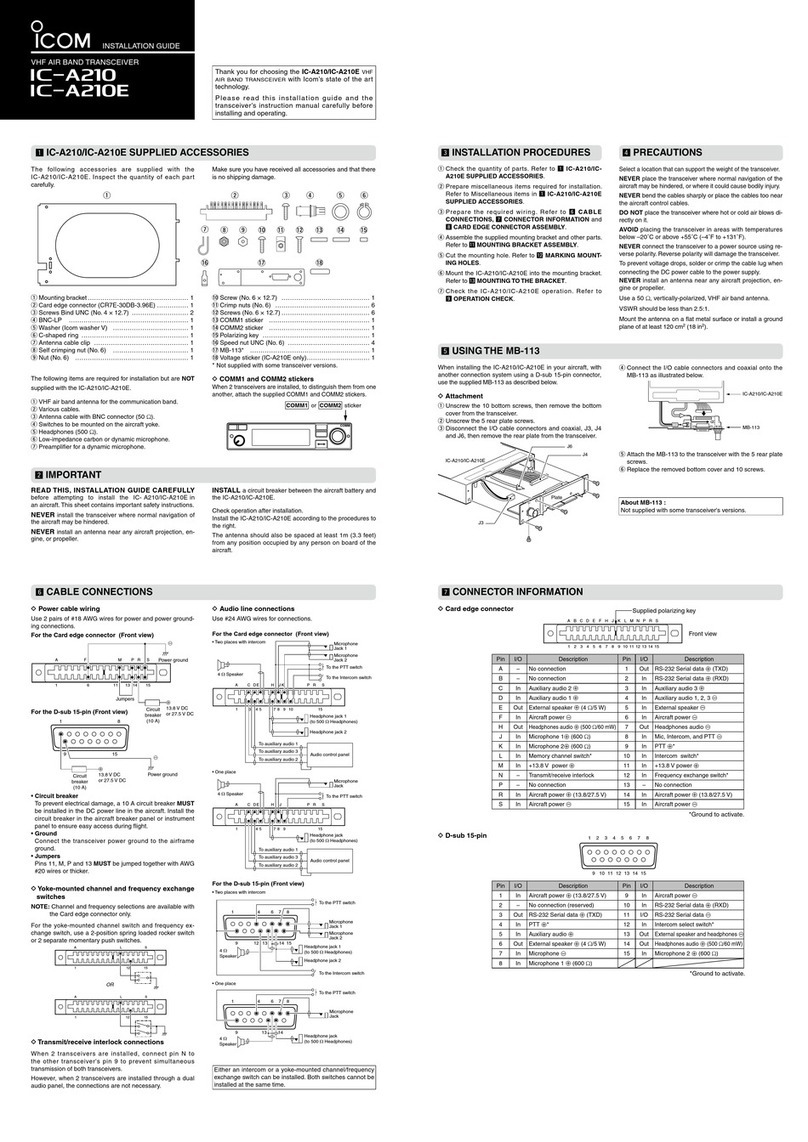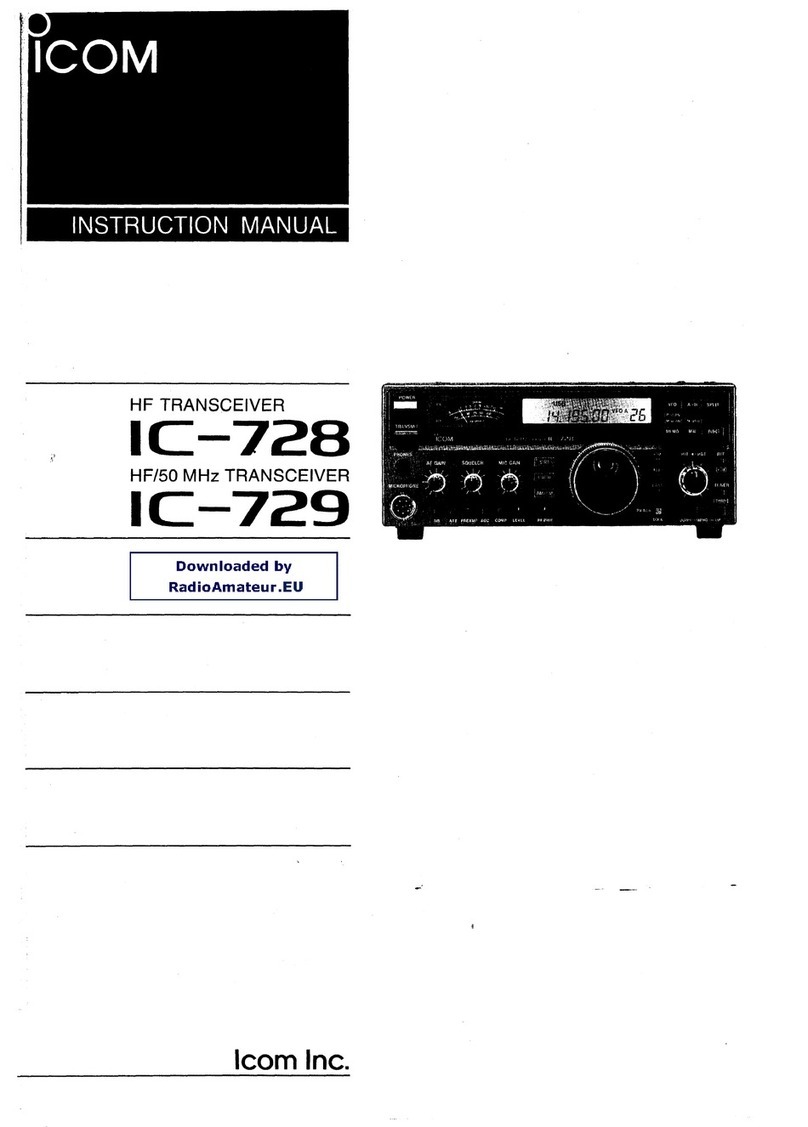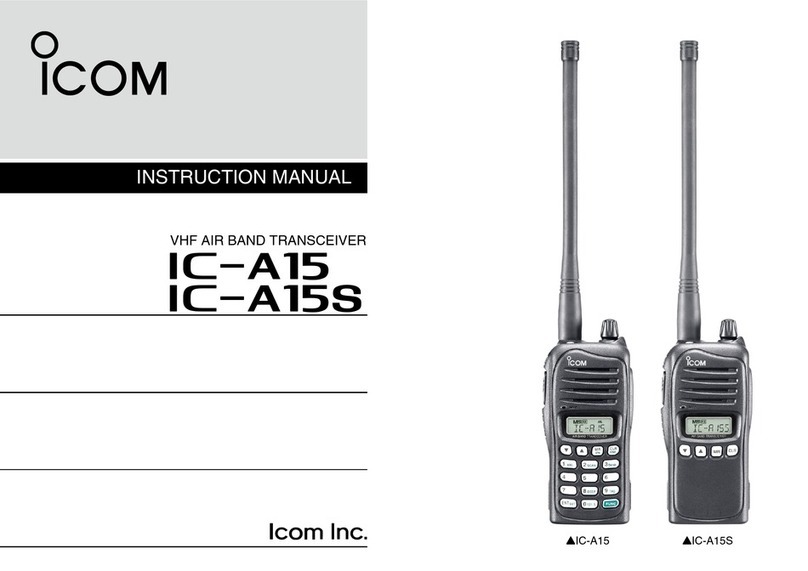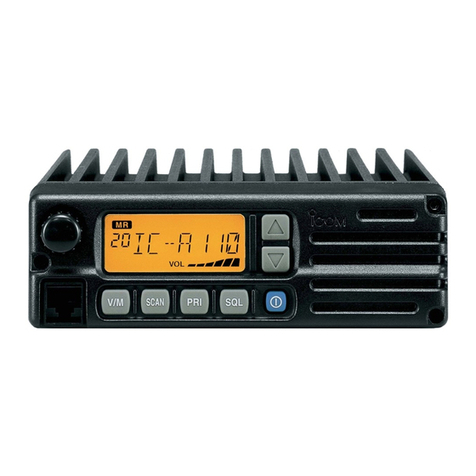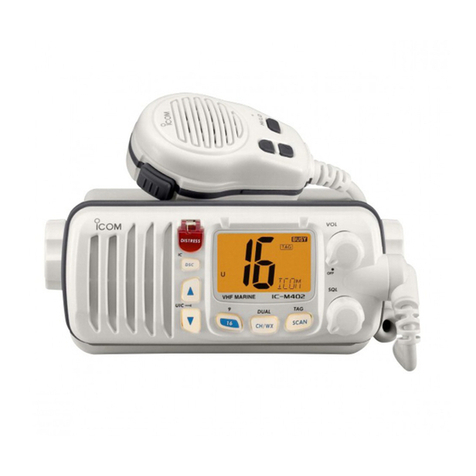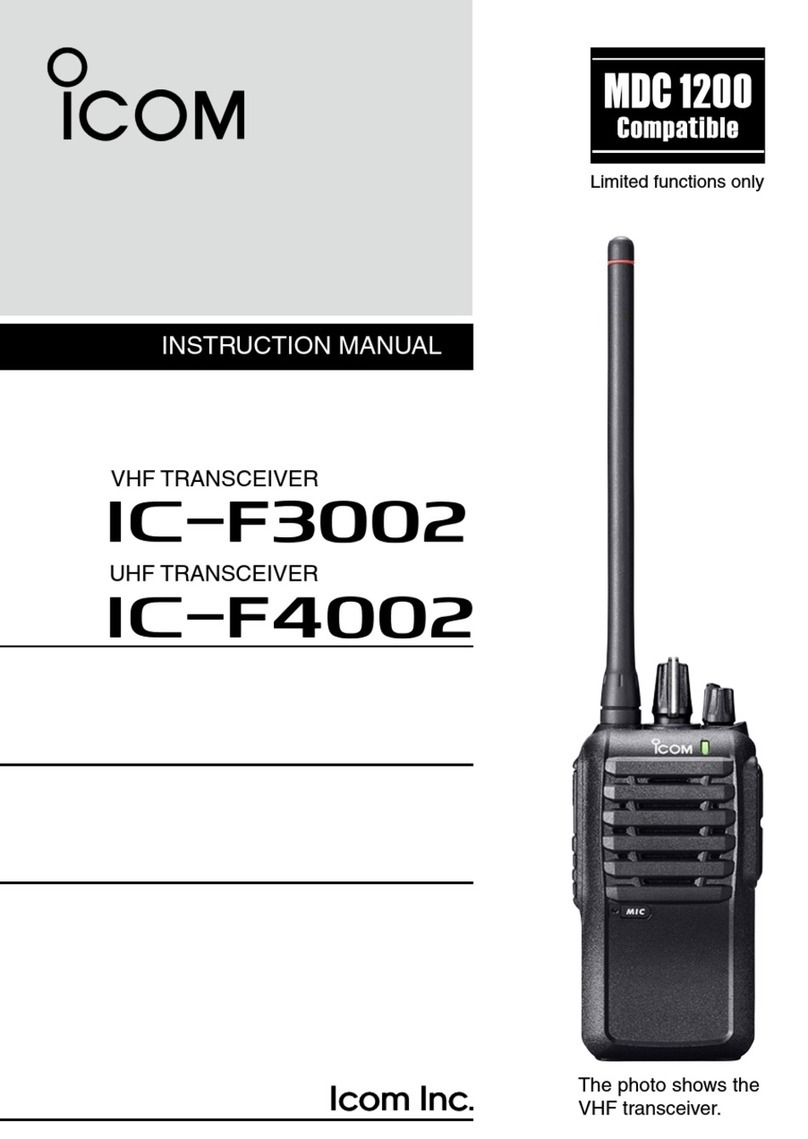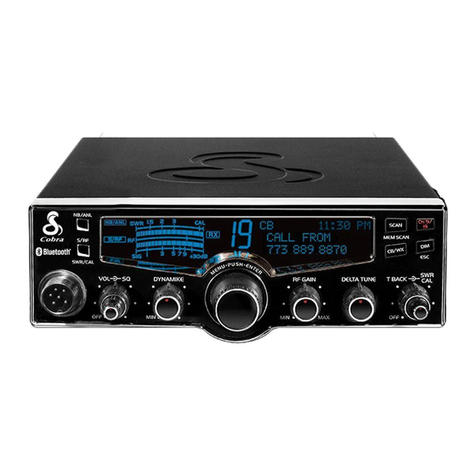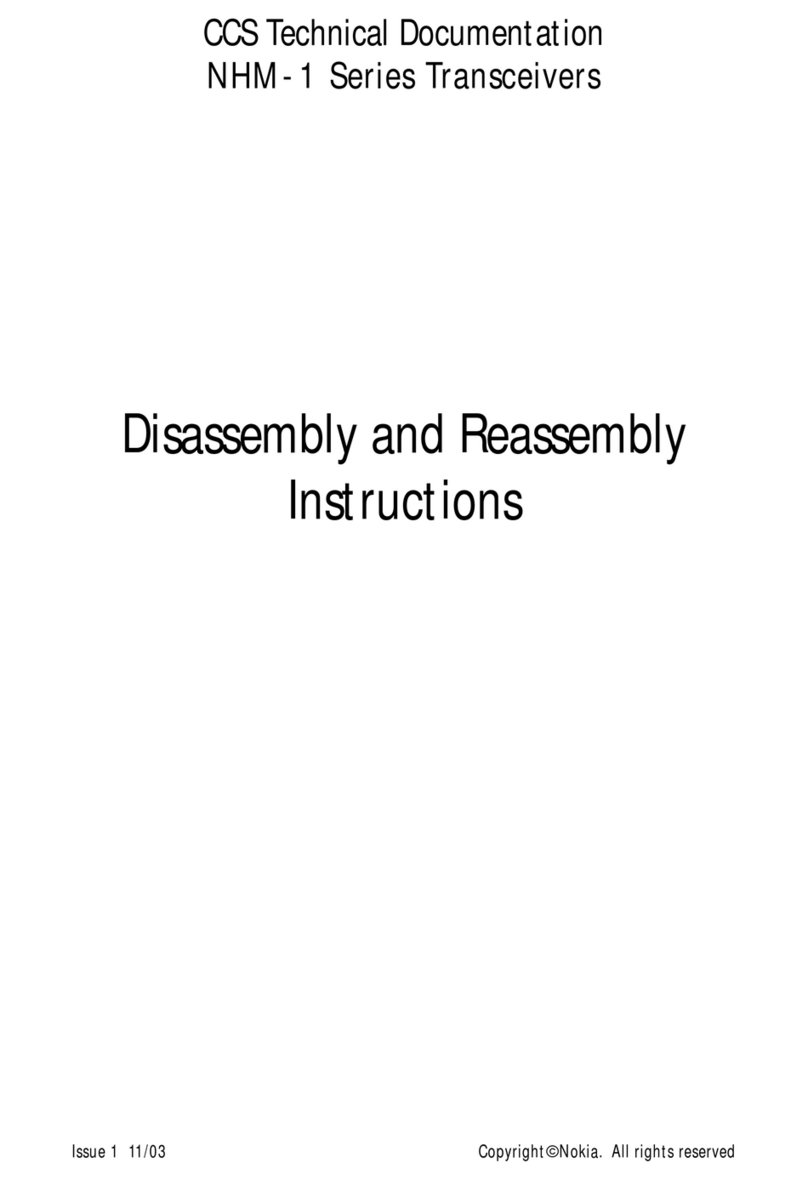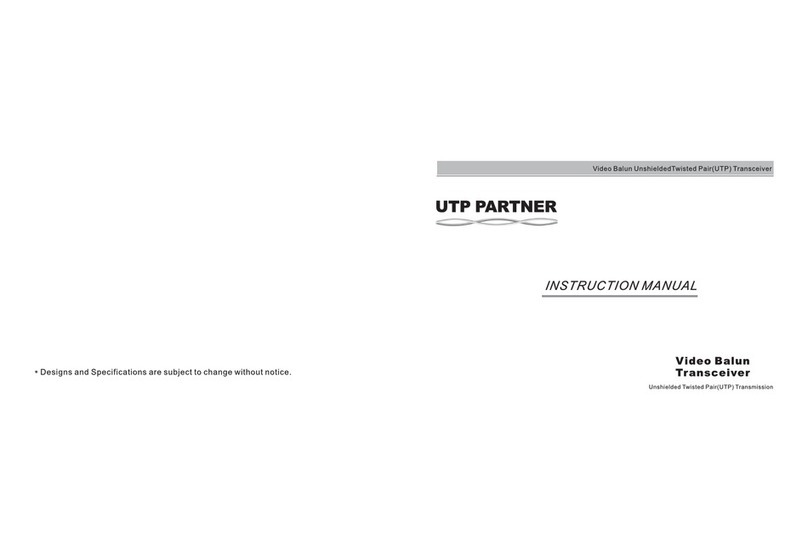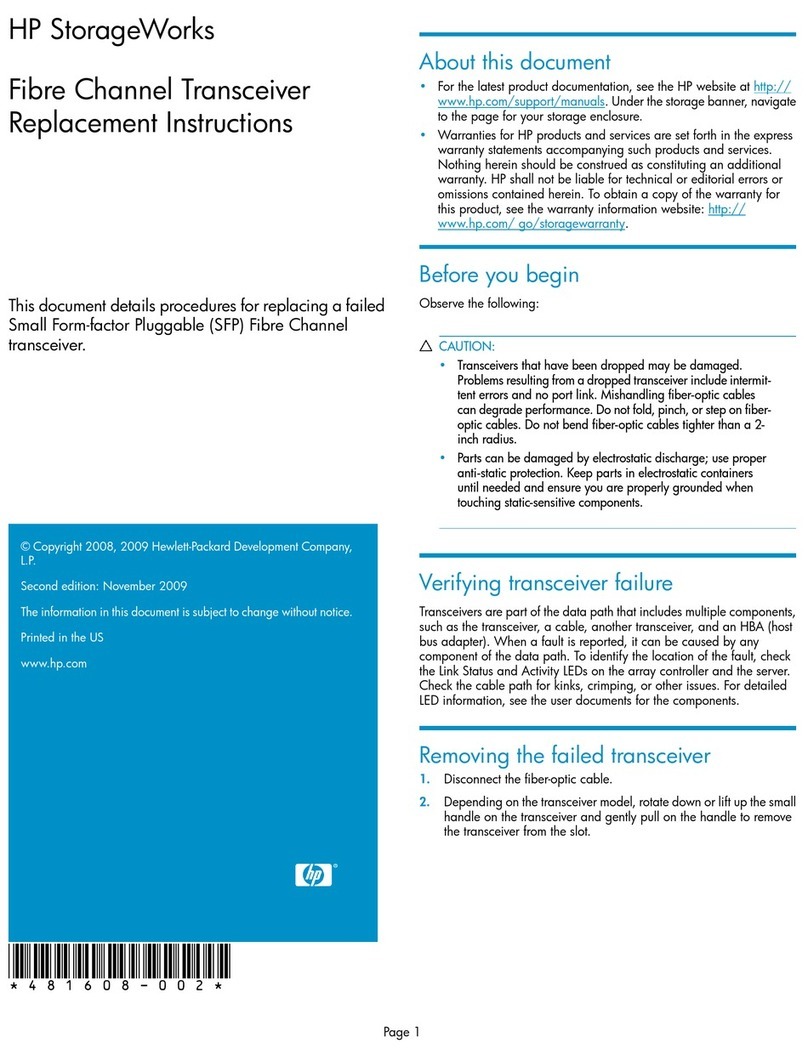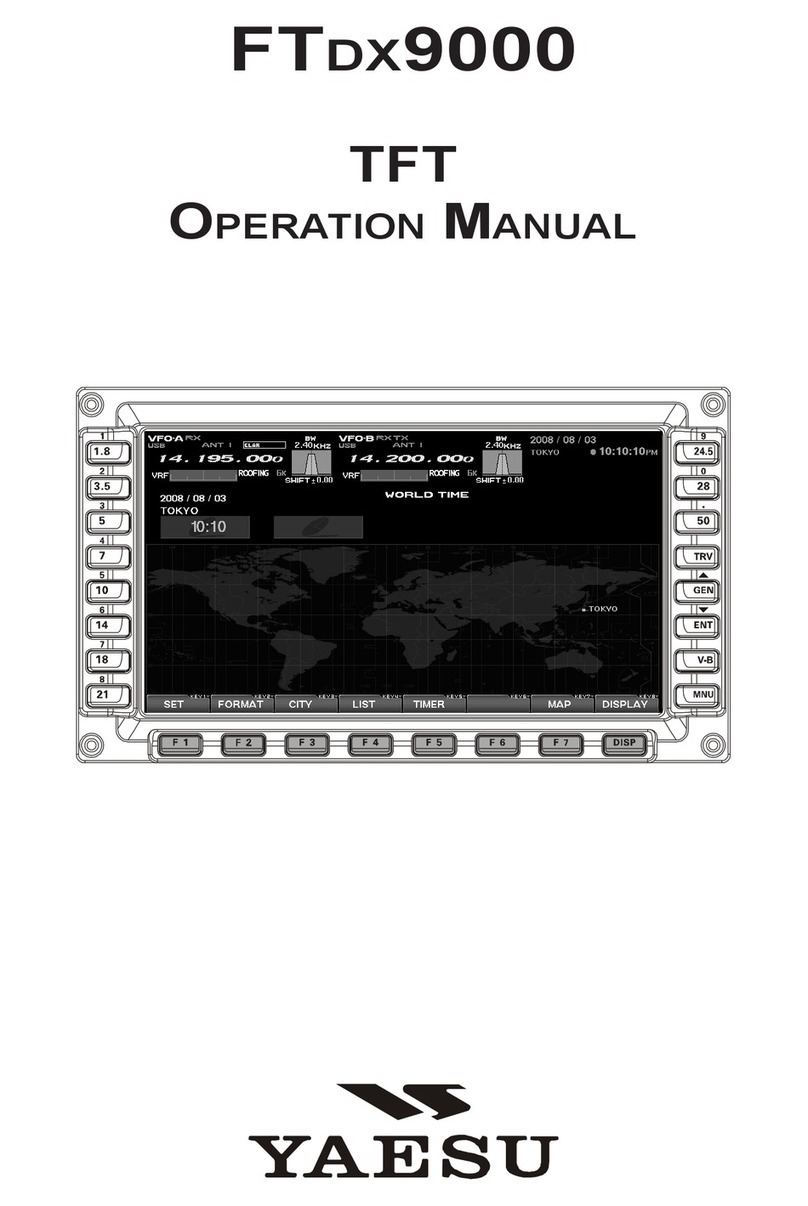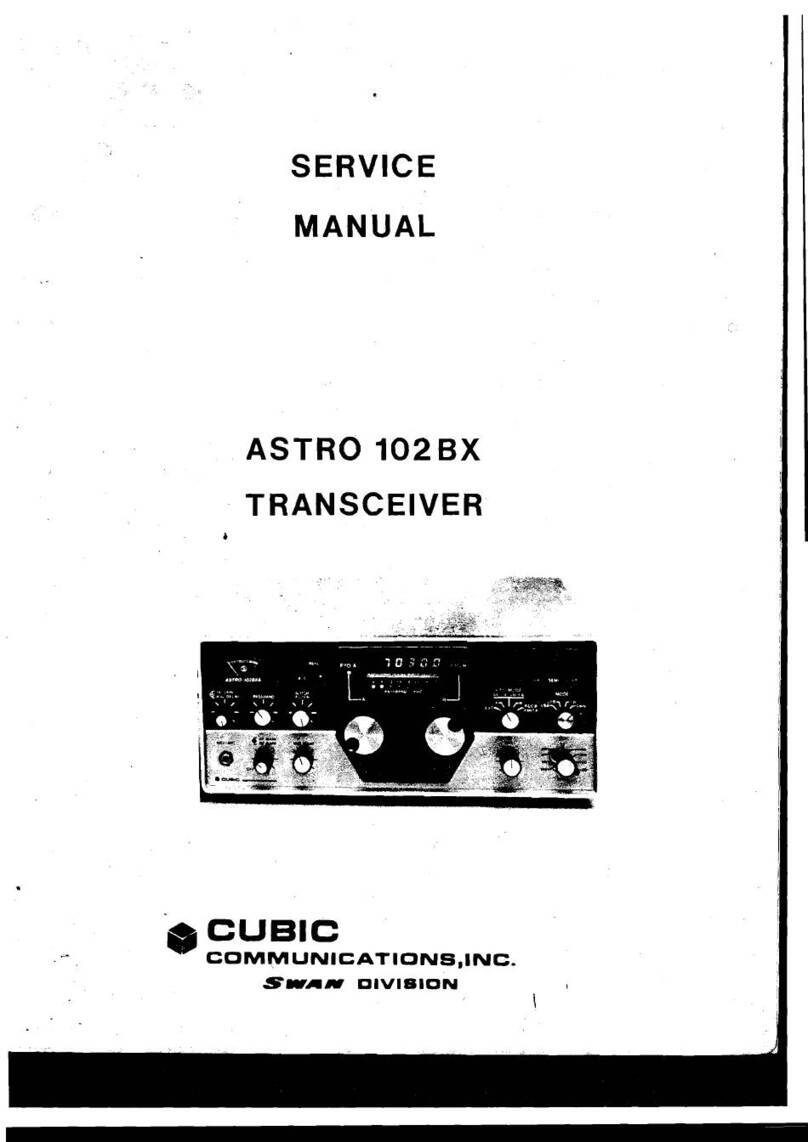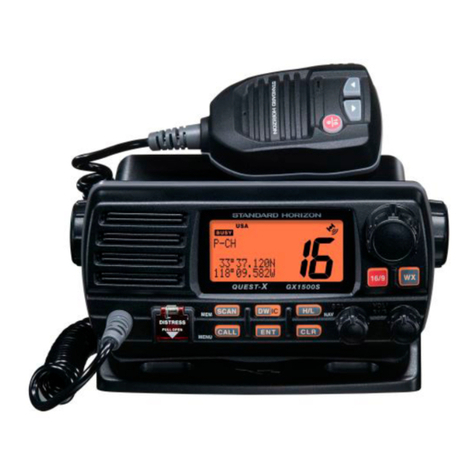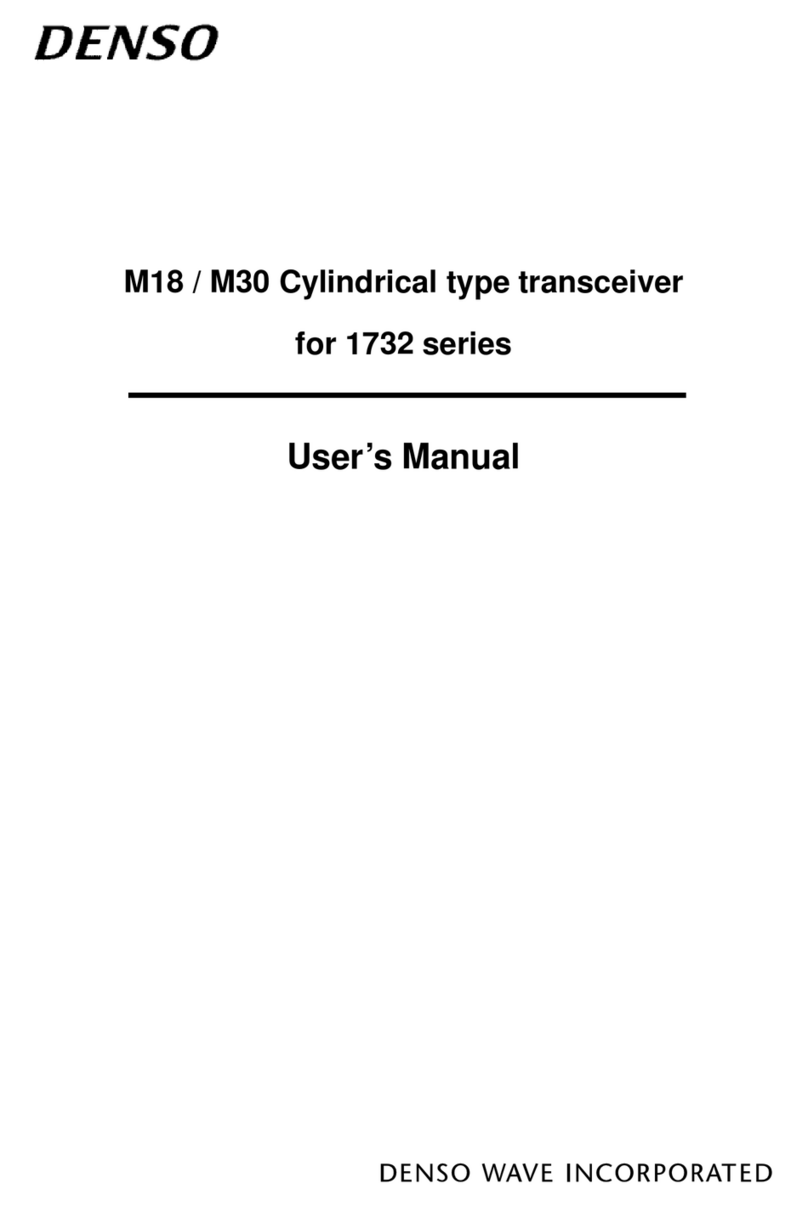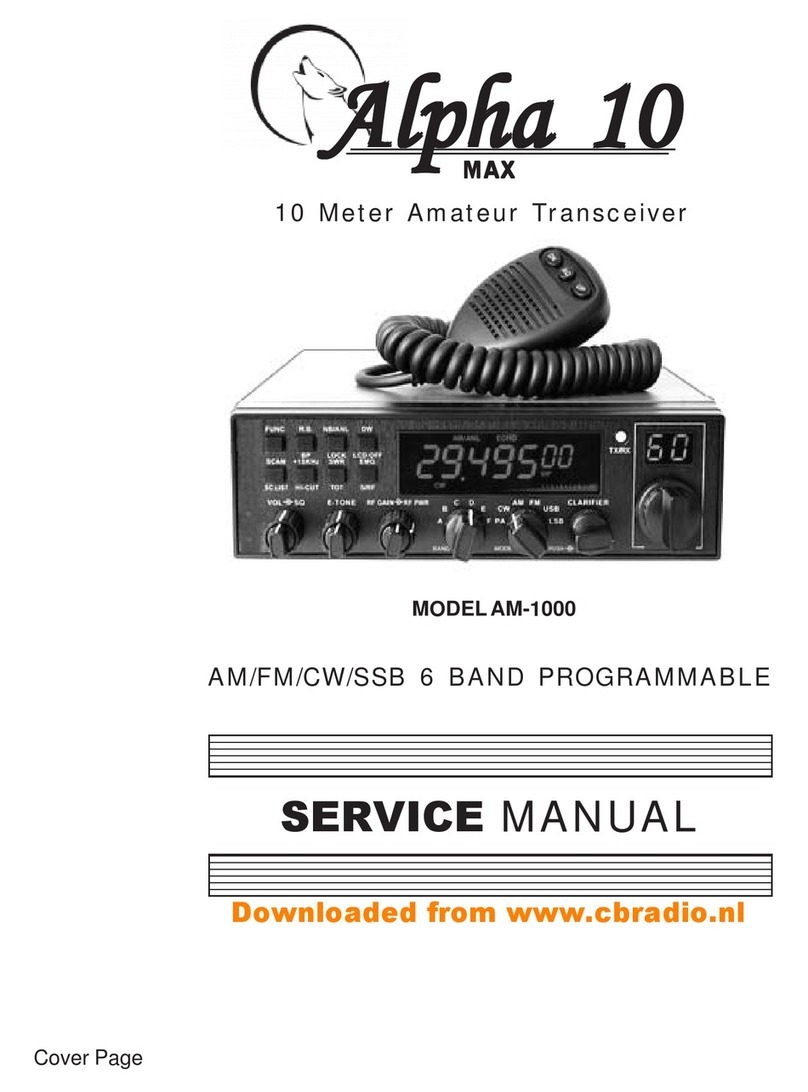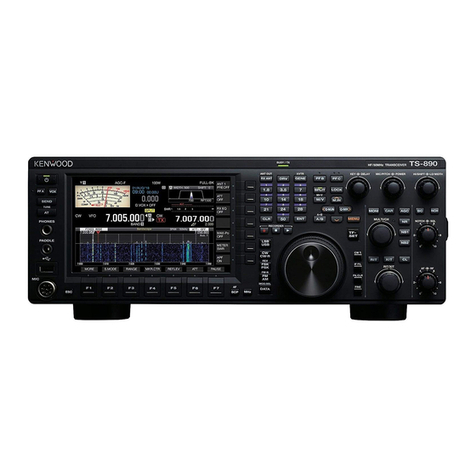Icom IC-M87 User manual

INSTRUCTION MANUAL
iM87
VHF MARINE TRANSCEIVER

i
FOREWORD
Thank you for choosing this Icom product. This product is de-
signed and built with Icom’s state of the art technology and
craftsmanship. With proper care this product should provide you
with years of trouble-free operation.
IMPORTANT
READ ALL INSTRUCTIONS carefully and com-
pletely before using the transceiver.
SAVE THIS INSTRUCTION MANUAL—This
instruction manual contains important operating instructions
for the IC-M87.
EXPLICIT DEFINITIONS
WORD DEFINITION
RDANGER! Personal death, serious injury or an explo-
sion may occur.
RWARNING! Personal injury, fire hazard or electric
shock may occur.
CAUTION Equipment damage may occur.
NOTE
If disregarded, inconvenience only. No risk
of personal injury, fire or electric shock.
FEATURES
☞22 free channels for PMR use
The IC-M87 has 22 free channels reserved for PMR
use
(146–174MHz). Wide/narrow
channel spacing is program-
mable for each channel, and CTCSS and DTCS signaling
is included.
*Appropriate license will be required.
☞Tough waterproof construction
The IC-M87 is built tough to withstand hazardous and un-
hospitable environments at sea and on land. Even if the
IC-M87 is dropped into water, it’s waterproofing* will pro-
tect it from harm. The compact and durable body meets
the military specifications (MIL-STD).
* Equivalent to JIS waterproof grade 7 or IPX7 of the correspond-
ing International Standard IEC 529 (1989). (1m depth for 30
minutes)
☞Simple operation
6 clearly labelled buttons on the front panel and the vol-
ume/power knob maximize simplicity of operation. Even
when wearing gloves, the large buttons are easy to oper-
ate. A large, clear LCD with backlighting and backlit but-
tons make night time operation simple.

IN CASE OF EMERGENCY
If your vessel requires assistance, contact other vessels and
the Coast Guard by sending a distress call on Channel 16.
❍USING CHANNEL 16
DISTRESS CALL PROCEDURE
1. “MAYDAY MAYDAY MAYDAY.”
2. “THIS IS ...........................” (name of vessel)
3.Your call sign or other indication of the ves-
sel.
4. “LOCATED AT ..................... ” (your position)
5. The nature of the distress and assistance re-
quired.
6. Any other information which might facilitate
the rescue.
RECOMMENDATION
CLEAN THE TRANSCEIVER THOROUGHLY WITH FRESH
WATER after exposure to saltwater, and dry it before operat-
ing. Otherwise, the transceiver's keys, switches and control-
lers may become unusable, due to salt crystallization, and/or
the charging terminals of the battery pack may rust.
NOTE: If the transceiver’s waterproof protection appears
defective, carefully clean it with a soft, wet (fresh water)
cloth, then, dry it before operating.
The transceiver may lose its waterproof protection if the
case, jack cap, or connector cover is cracked or broken, or
the transceiver has been dropped.
ii

iii
PRECAUTIONS
RDANGER! NEVER short terminals of the battery pack.
Also, current may flow into nearby metal objects such as a
key, so be careful when placing the battery packs (or the
transceiver) in handbags, and so on. Simply carrying with or
placing near metal objects such as a key, and so on may
cause shorting. This may damage not only the battery pack,
but also the transceiver.
RDANGER! Use and charge only specified Icom bat-
tery packs with Icom transceivers or Icom chargers. Only
Icom battery packs are tested and approved for use with Icom
transceivers or charged with Icom chargers. Using third-party
or counterfeit battery packs or chargers may cause smoke,
fire, or cause the battery to burst.
RWARNING! NEVER connect the transceiver to an AC
outlet. This may pose a fire hazard or result in an electric
shock.
RWARNING! NEVER hold the transceiver so that the an-
tenna is very close to, or touching exposed parts of the body,
especially the face or eyes, while transmitting. The trans-
ceiver will perform best if the microphone is 5 to 10 cm away
from the lips and the transceiver is vertical.
CAUTION: NEVER connect the transceiver to a power
source other than the BP-227AX. Such a connection will ruin
the transceiver.
CAUTION: MAKE SURE the flexible antenna and battery
pack are securely attached to the transceiver, and that the
antenna and battery pack are dry before attachment. Expos-
ing the inside of the transceiver to water will result in serious
damage to the transceiver.
After exposure to water, clean the battery contacts thoroughly
with fresh water and dry them completely to remove any
water or salt residue.
DO NOT push [PTT] when you do not actually intend to
transmit.
DO NOT operate or place the transceiver in direct sunlight
or in areas with temperatures below –15°C or above +55°C:
Marine, below –25°C or above +55°C: PMR.
DO NOT modify the transceiver. The specifications may
change and then not comply with the requirements of a
corresponded regulation. The transceiver warranty does not
cover any problems caused by unauthorized modification.
DO NOT use harsh solvents such as benzine or alcohol
when cleaning, as they will damage the transceiver surfaces.
KEEP the transceiver out of the reach of children.
KEEP the transceiver at least 0.9 meter away from your ves-
sel’s magnetic navigation compass.

iv
Icom, Icom Inc. and Icom logo are registered trademarks of Icom Incorporated
(Japan) in Japan, the United States, United Kingdom, Germany, France, Spain,
Russia, Australia, New Zealand, and/or other countries.
PRECAUTIONS
Icom is not responsible for the destruction or damage to the
Icom transceiver, if the malfunction is because of:
• Force majeure, including, but not limited to, fires, earth-
quakes, storms, floods, lightnings, or other natural disas-
ters, disturbances, riots, war, or radioactive contamination.
• The use of Icom transceiver with any equipment that is not
manufactured or approved by Icom.
BE CAREFUL! The transceiver meets IPX7* requirements
for waterproof protection. However, once the transceiver has
been dropped, waterproof protection cannot be guaranteed
because of possible damage to the transceiver's case or the
waterproof seal.
* Only when the BP-227AX, flexible antenna, [SP MIC] jack
cover is attached.
BE CAREFUL! The transceiver will become hot when
operating it continuously for long periods of time.
MAKE SURE to turn OFF the transceiver power before
connecting or disconnecting the supplied or optional accessory.

v
INTRINSIC SAFETY
Versions of the IC-M87 which display the “EX”
marking on the serial number seal.
The approval rating for these models is II 2G Ex
ib II A T3 Gb.
WARNING! NEVER charge the BP-227AX (with/without
the transceiver) in an explosive atmosphere. The optional bat-
tery chargers are not approved as Intrinsically Safe.
When the transceiver is used in a hazardous area, the
BP-227AX MUST be attached, either the jack cover or HM-
138 MUST be attached to the speaker-microphone connec-
tor.
KEEP the transceiver and the BP-227AX clean to avoid any
risk of ignition due to the build-up of electrostatic charges.
Repair of Icom transceivers should only be carried out by
authorized Icom distributors. In particular, repair of ATEX ap-
proved transceivers can ONLY be done by Icom to main-
tain the intrinsically safe rating. NEVER attempt to repair an
ATEX approved transceivers. Only Icom has the repair exper-
tise and procedures to maintain the ATEX approval. Contact
your Icom distributor or authorised dealer for details.
The ATEX standard is described on the sticker (Ex Marking)
and BP-227AX as below.
BP-227AX
ϩ2G Ex b ϩ
A T3 Gb
• DO NOT OPEN WHEN AN EXPLOSIVE ATMOSPHERE
MAY BE PRESENT.
• DO NOT CHARGE THE BATTERY IN HAZARDOUS
LOCATION.
The equipment can be used without the microphone but
with the jack cover.

vi
The crossed-out wheeled-bin symbol on your
product, literature, or packaging reminds you that
in the European Union, all electrical and
electronic products, batteries, and accumulators
(rechargeable batteries) must be taken to
designated collection locations at the end of their
working life. Do not dispose of these products as unsorted
municipal waste. Dispose of them according to the laws in
your area.
DISPOSAL COUNTRY CODE LIST
• ISO 3166-1
Country Codes Country Codes
1
2
3
4
5
6
7
8
9
10
11
12
13
14
15
16
17
Austria
Belgium
Bulgaria
Croatia
Czech Republic
Cyprus
Denmark
Estonia
Finland
France
Germany
Greece
Hungary
Iceland
Ireland
Italy
Latvia
AT
BE
BG
HR
CZ
CY
DK
EE
FI
FR
DE
GR
HU
IS
IE
IT
LV
18
19
20
21
22
23
24
25
26
27
28
29
30
31
32
33
Liechtenstein
Lithuania
Luxembourg
Malta
Netherlands
Norway
Poland
Portugal
Romania
Slovakia
Slovenia
Spain
Sweden
Switzerland
Turkey
United Kingdom
LI
LT
LU
MT
NL
NO
PL
PT
RO
SK
SI
ES
SE
CH
TR
GB

TABLE OF CONTENTS
FOREWORD ......................................................................... i
IMPORTANT.......................................................................... i
EXPLICIT DEFINITIONS....................................................... i
FEATURES............................................................................ i
IN CASE OF EMERGENCY................................................. ii
RECOMMENDATION ........................................................... ii
PRECAUTIONS................................................................... iii
INTRINSIC SAFETY............................................................. v
DISPOSAL........................................................................... vi
COUNTRY CODE LIST ....................................................... vi
1 OPERATING RULES.......................................................1
2 SUPPLIED ACCESSORIES AND ATTACHMENTS....2–3
3 PANEL DESCRIPTION................................................4–7
■Front, top and side panels............................................4
■Function display ...........................................................6
4 BASIC OPERATION..................................................8–12
■Channel selection.........................................................8
■Receiving and transmitting.........................................10
■Adjusting the squelch level.........................................11
■Automatic backlighting ...............................................11
■Lock function ..............................................................11
■Call channel programming .........................................12
■Voice scrambler operation ..........................................12
5 SCAN OPERATION.................................................13–14
■Scan types .................................................................13
■Setting TAG channels .................................................14
■Starting a scan ...........................................................14
6 DUALWATCH/TRI-WATCH............................................15
■Description .................................................................15
■Operation....................................................................15
7 LAND (PMR) CHANNEL OPERATION .........................16
■LAND (PMR) Channel group.....................................16
■Function display.........................................................16
8 SET MODE ..............................................................17–21
■Set mode programming..............................................17
■Set mode items ..........................................................18
9 BATTERY CHARGING ............................................22–27
■Caution.......................................................................22
■AD-100 installation .....................................................26
■Optional battery chargers...........................................26
10 SPEAKER-MICROPHONE............................................28
■HM-138 Description ...................................................28
■Attachments ...............................................................28
11 TROUBLESHOOTING...................................................29
12 VHF MARINE CHANNEL LIST .....................................30
13 SPECIFICATIONS .........................................................31
14 OPTIONS.......................................................................32
15 QUICK REFERENCE ....................................................33
16 DOC ...............................................................................34
17 ATEX CAUTIONS ..........................................................35
INDEX...........................................................................36–38
vii

1
1
OPERATING RULES
D Priorities
• Read all rules and regulations pertaining to priorities and
keep an up-to-date copy handy. Safety and distress calls
take priority over all others.
• You must monitor Channel 16 when you are not operating
on another channel.
• False or fraudulent distress calls are prohibited under law.
D Privacy
• Information overheard but not intended for you cannot law-
fully be used in any way.
• Indecent or profane language is prohibited.
D Radio licenses
(1) SHIP STATION LICENSE
When your craft is equipped with a VHF FM transceiver, you
must have a current radio station license before using the
transceiver. It is unlawful to operate a ship station which is
not licensed.
Inquire through your dealer or the appropriate government
agency for a Ship-Radiotelephone license. This license in-
cludes the call sign which is your craft’s identification for radio
purposes.
(2) OPERATOR’S LICENSE
A restricted Radiotelephone Operator Permit is the license
most often held by small vessel radio operators when a radio
is not required for safety purposes.
The Restricted Radiotelephone Operator Permit must be
posted near the transceiver or be kept with the operator. Only
a licensed radio operator may operate a transceiver.
However, non-licensed individuals may talk over a transceiver
if a licensed operator starts, supervises, ends the call and
makes the necessary log entries.
A current copy of the applicable government rules and regu-
lations is only required to be on hand for vessels in which
a radio telephone is compulsory. However, even if you are
not required to have these on hand it is your responsibility to
be thoroughly acquainted with all pertinent rules and regula-
tions.

DSupplied accessories
The following accessories are supplied: Qty.
• Swivel belt clip ................................. 1
• Stopper for the swivel belt clip ..................... 1
• Screws for the swivel belt clip...................... 2
• Flexible antenna ................................ 1
• Handstrap..................................... 1
• Battery pack ................................... 1
• Power adapter*................................. 1
• Battery charger................................. 1
*Not supplied with some version
DSwivel belt clip
To attach:
qAttach the stopper to the back of the transceiver.
Supplied screws
Stopper
wClip the belt clip to a part of your belt and insert the stop-
per to the belt clip.
eOnce the transceiver is locked in place, it will swivel 360
degrees.
2
2SUPPLIED ACCESSORIES AND ATTACHMENTS

To remove:
Turn the transceiver upside down, and then lift up to release
the transceiver from the belt clip.
CAUTION:
HOLD THE TRANSCEIVER TIGHTLY, WHEN ATTACHING
OR REMOVING THE TRANSCEIVER FROM THE BELT
CLIP.
If the transceiver is accidentally dropped and the swivel
belt clip’s stopper is scratched or damaged, the swivel belt
clip may not work properly.
DFlexible antenna
Connect the supplied flexible antenna
to the antenna connector.
CAUTION:
• NEVER carry the transceiver by
holding the antenna.
• DO NOT connect the antenna
other than listed on page 32.
• Transmitting without an antenna
may damage the transceiver.
DHandstrap
Pass the handstrap through
the loop on the back side of
the transceiver as illustrated
at right. This facilitates carry-
ing.
3
2
SUPPLIED ACCESSORIES AND ATTACHMENTS

qVOLUME CONTROL [VOL]
Turns power ON and adjusts the audio level.
wANTENNA CONNECTOR (p. 3)
Connects the supplied antenna.
eSPEAKER-MICROPHONE CONNECTOR [SP MIC] (p. 28)
Connects the optional speaker-microphone.
[SP MIC] jack cover
NOTE: KEEP the [SP MIC]
jack cover attached to th
e
transceiver when the speaker-
microphone is not in use.
rSCAN [SCN•DUAL]
• Starts or cancels the Normal or Priority scan. (p. 14)
• Enters watch mode when held down for 1 second. (p. 15)
tTRANSMIT POWER/LOCK SWITCH [H/L•LOCK]
• Selects high, middle (except for the German version) or
low power when pushed. (p. 10)
• Toggles the Lock function ON/OFF when held down for 1
second. (p. 11)
yCHANNEL 16 SWITCH [16•C]
• Selects Channel 16 when pushed. (p. 8)
• Selects the Call channel when held down for 1 second.
(p. 8)
•
Enters the Call channel programming mode when the Call
channel is selected and this switch is held down for 3 sec-
onds. (p. 12)
■Front, top and side panels
u
r
t
i
o
!0
q
w
y
e
4
3PANEL DESCRIPTION

ïBATTERY PACK RELEASE BUTTON
To release the battery pack:
Push the battery release button in the direction of the arrow
(q) as shown below. The battery pack is then released.
To attach the battery pack:
Slide the battery pack on the back of the transceiver in the
direction of the arrow (w), then lock it with the battery release
button.
*Slide the battery pack until the battery release button makes a ‘click’
sound.
w
q
Battery pack
Battery release button
CAUTION: When pushing the battery release button, slide
the battery pack slightly in the direction of the arrow (w) to
ease release. This will prevent possible injuring to your fin-
gers or nails
uCHANNEL UP/DOWN SWITCHES [Y]/[Z]
• Select an operating channel. (p. 8)
• Selects the Set mode condition of item. (p. 17)
• Checks TAG channels or changes scanning direction dur-
ing scan. (p. 14)
• Sets and clears the displayed channel as a TAG
(scanned) channel when held down both switches for 1
second.
• While turning power ON, clears all TAG channels in the
selected channel group when both switches are pushed.
iDIAL/CHANNEL GROUP SWITCH [DIAL]
• Selects one of 3 regular channels in sequence when held
down for 1 second. (pp. 9, 16)
- International, USA (or ATIS*) and LAND (PMR) channels are
available. *German version only
• Push to return to the condition before selecting the chan-
nel when the priority channel or the Call channel is se-
lected.
o SQUELCH SWITCH [SQL] (p. 11)
• Push this switch, then set the squelch level with [Y]/[Z].
• Manually opens the squelch for channel monitoring while
holding down.
• While holding down this switch, turn ON the transceiver
to enter the Set mode.
!0 PTT SWITCH [PTT]
Hold down to transmit, release to receive.
5
3
PANEL DESCRIPTION

■Function display
qweruy
t
i
!
1
!2
!3
!4
!5
o
!0
qTRANSMIT ICON (p. 10)
Displayed while transmitting.
wBUSY ICON (p. 10)
• Displayed when receiving a signal or when the squelch
opens.
• Blinks while monitoring.
eTAG CHANNEL ICON (p. 14)
Displayed when a TAG channel is selected.
rSCAN INDICATOR (p. 14)
Blinks while scanning.
tLOCK ICON (p. 11)
Displayed while the lock function is activated.
yNARROW ICON (p. 16)
Displayed when narrow channel spacing is selected.
*LAND (PMR) channel group only.
uBATTERY INDICATOR
Displays the remaining battery power.
Indication
Full Middle Charging
required Discharged
Battery level
blinks when the battery is over charged.
6
3PANEL DESCRIPTION

iDUALWATCH/TRI-WATCH INDICATORS (p. 15)
• “DUAL” is displayed during Dualwatch.
• “TRI” is displayed during Tri-watch.
oSCRAMBLER INDICATOR
Displayed when the optional voice scrambler is activated.
(pp. 12, 21)
!0DUPLEX INDICATOR
Displayed when a duplex channel is selected.
!1SUB CHANNEL READOUT
• Displays Channel 16 during priority scan, Dualwatch or
Tri-watch. (p. 15)
• Displays the Set mode item while in the Set mode.
!2CHANNEL NUMBER READOUT
• Displays the selected operating channel number.
• Displays the selected condition while in the Set mode.
!3CALL CHANNEL INDICATOR (p. 8)
Displayed when the Call channel is selected.
!4CHANNEL GROUP ICONS (pp. 9, 16)
• “I” is displayed when International channel group is se-
lected.
• “U” is displayed when USA channel group is selected
(UK version only).
• “ ” is displayed when LAND (PMR) channel group is
selected.
• “ATIS” is displayed when the channel group in which ATIS
function is activated. (German version only)
!5TRANSMIT POWER INDICATORS (p. 10)
• “LOW” is displayed when low power is selected.
• “MID” is displayed when middle power is selected. (Ex-
cept for the German version)
• No indicator is displayed when high power is selected.
7
3
PANEL DESCRIPTION

DCall channel
Each regular channel group has a separate Call channel. In
addition, each Call channel is monitored during Tri-watch.
The Call channels can be reprogrammed and are used to
store your most often used channels in each channel group
for quick recall.
qHold down [16•C] for 1 second to select the Call channel in
the selected channel group.
• “CALL” and the Call channel number are displayed.
• Each channel group may have its own Call channel after pro-
gramming a Call channel. See the “Call channel programming”
on page 12 for details.
wPush [DIAL] to return to the condition before selecting the
Call channel, or push [Y] or [Z] to select the operating
channel.
C
Push
for 1 second
■Channel selection
IMPORTANT: Prior to using the transceiver for the first
time, the battery pack must be fully charged for optimum
life and operation. To avoid damage to the transceiver, turn
the power OFF while charging.
DChannel 16
Channel 16 (Distress channel) is used for establishing initial
contact with another station and for emergency communica-
tions. Channel 16 is automatically monitored during both Du-
alwatch and Tri-watch. While standing by, you must monitor
Channel 16.
qPush [16•C] to select Channel 16.
wPush [DIAL] to return to the condition before selecting
Channel 16, or push [Y] or [Z] to select the operating
channel.
C
Push
Channel 16 is the default setting.
(depending on version)
8
4BASIC OPERATION

DInternational, USA and ATIS* channels
There are 57 International, 58 USA and 57 ATIS* channels.
These channel groups may be specified for the operating
area.
qPush [DIAL] to select a regular channel.
wPush [Y] or [Z] to select a channel.
• “DUP” is displayed for duplex channels.
eTo change the channel group, hold down [DIAL] for 1 sec-
ond.
• International, USA and ATIS* channels can be selected in se-
quence. Depending on the setting, LAND (PMR) channel can
be selected. See the “LAND (PMR) CHANNEL OPERATION” on
page 16 for details.
* German version only
USA channels
International channels
ATIS channels*
Hold down
f
or 1 second
Hold down
for 1 second
9
4
BASIC OPERATION

■Receiving and transmitting
CAUTION: Transmitting without an antenna may damage
the transceiver.
q Rotate [VOL] clockwise to turn ON the transceiver.
w Push [SQL] to enter the squelch adjustment mode, then push
[Y] or [Z] to set the squelch level.
e Hold down [SQL] for 1 second to open the squelch, then
rotate [VOL] to set the volume level while holding down the
[SQL] key. (See the Set mode item “Monitor switch action”
on page 19.)
r Push [Y] or [Z] to select the desired channel.
- When receiving a signal, “ ” is displayed, and audio is emit-
ted from the speaker.
- Further adjustment of [VOL] may be necessary at this point.
t Push [H/L•LOCK] to select the output power if necessary.
- “LOW” is displayed when low power is selected.
“MID” is displayed when middle power is selected (except for
the German version).
No indication when high power is selected.
- Choose low power for short range communications, choose high
power for longer distance communications.
- Some channels are for low power only.
y Hold down [PTT] to transmit, then speak into the micro-
phone.
- “TX” is displayed.
- Channel 70 cannot be used for transmission (for GMDSS use).
u Release [PTT] to receive.
IMPORTANT: To maximize the readability of your transmit-
ted signal, pause a few second after pushing [PTT], hold
the microphone 5 to 10 cm from your mouth and speak at
a normal voice level.
NOTE: The transceiver has a power save function to con-
serve the battery power and it cannot be turned OFF. The
power save function automatically activates when no sig-
nal is received for 5 seconds.
Hold down
to transmit.
Release to
receive.
y
u
Enter the
squelch
adjustment
mode
Open the
squelch
w
e
w
r
Set the
squelch level
Set channel
q
e
Power ON
Set the
volume level
tSet output
power
10
4BASIC OPERATION

■Adjusting the squelch level
The IC-M87 has a squelch even though there is no control
knob for it. In order to receive signals properly, as well as for
the scan to function effectively, the squelch must be adjusted
to the proper level.
qPush [SQL] to enter the Squelch Adjustment mode, then ad-
just the squelch level with [Y] or [Z].
- “SL” is displayed.
- There are 11 squelch levels to choose from: OP is completely
open, 10 is the tight squelch level.
- After 5 seconds of inactivity, the transceiver returns to normal
condition.
wPush [SQL] again to return to normal condition.
■Automatic backlighting
This function is convenient for nighttime operation. The auto-
matic backlighting can be turned ON in the Set mode. (p. 19)
➥Push any key except for [PTT] to turn ON the LCD back-
light.
• The LCD backlight is automatically turned OFF after 5 seconds
of inactivity.
■Lock function
This function electronically locks all keys (except for [PTT],
[SQL] and [H/L•LOCK]) to prevent accidental channel changes
and function access.
➥Hold down [H/L•LOCK] for 1 second to turn the Lock func-
tion ON or OFF.
Displayed while the
Loc
k function is used.
11
4
BASIC OPERATION

■Call channel programming
Call channel is used to access Channel 16 (default Call
channel may differ, depending on the transceiver version),
however, you can program the Call channel with your most
often-used channels in each channel group for quick recall.
qHold down [DIAL] for 1 second
one or more times until the de-
sired channel group (USA, In-
ternational and ATIS) to be pro-
grammed is selected.
wHold down [16•C] for 1 second to
select the Call channel.
• “CALL” and Call channel number
are displayed.
eHold down [16•C] again for 3 sec-
onds (until a long beep changes
to 2 short beeps) to enter the Call
channel programming mode.
• Call channel number starts blinking.
rPush [Y] or [Z] to select the de-
sired channel.
tPush [16•C] to program the dis-
played channel as the Call chan-
nel.
• Call channel number stops blinking.
■Voice scrambler operation
DActivating the scrambler
The optional Voice Scrambler provides private communica-
tions. In order to receive or send scrambled transmissions,
you must first activate the Scrambler function.
qSelect an operating channel
except Channel 16 or 70.
wWhile holding down [SQL],
push [SCN•DUAL].
• “SCRM” is displayed.
eTo turn OFF the Scrambler
function, repeat step w.
• “SCRM” disappears.
DProgramming scramble codes
There are 32 codes (1 to 32) are usable for programming.
In order to understand each other, all transceivers in your
group must have the same scramble code, as well as the
same scrambler unit. See page 21 for scrambler code set-
ting details.
Appears when the
voice scrambler
function is in use.
12
4BASIC OPERATION
Other manuals for IC-M87
8
Table of contents
Other Icom Transceiver manuals

Icom
Icom IC-M423 User manual
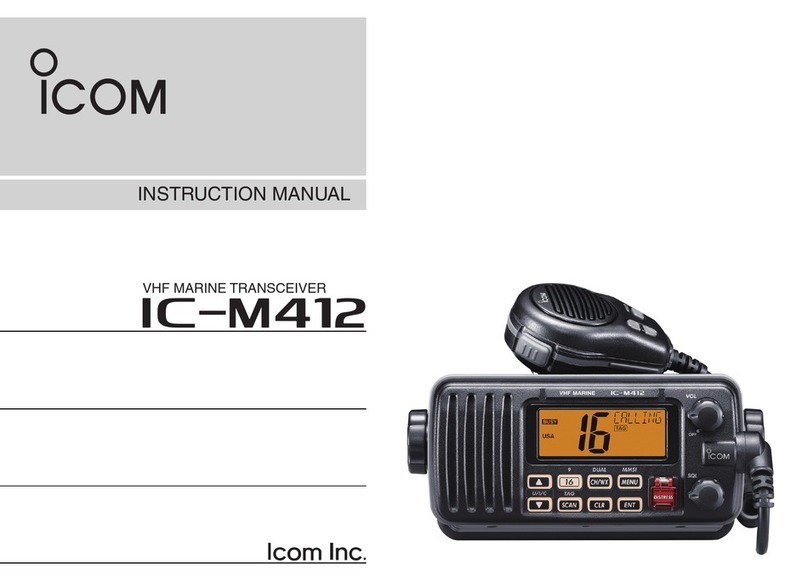
Icom
Icom IC-M412 User manual
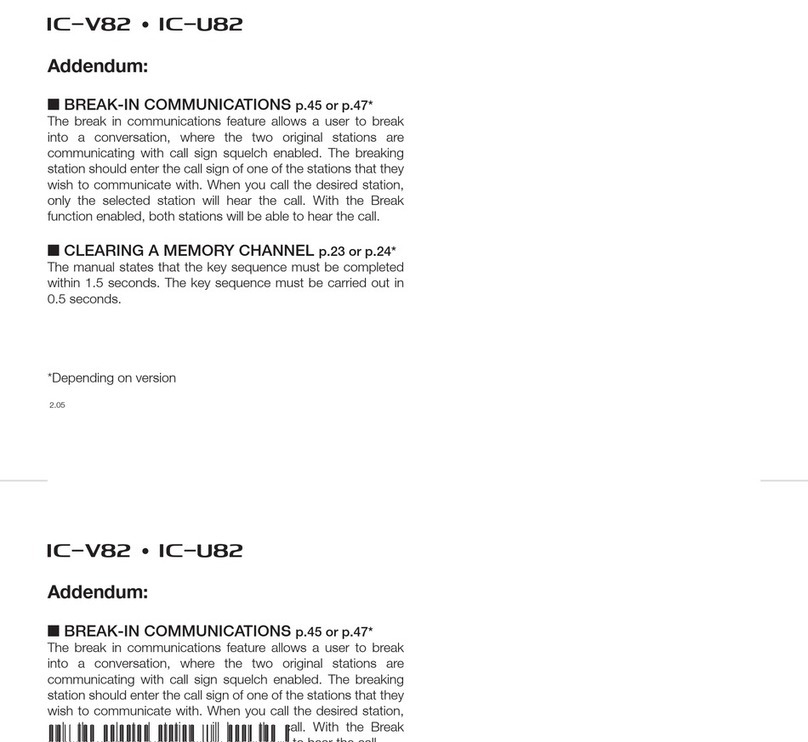
Icom
Icom IC-U82 Installation and operating instructions

Icom
Icom IC-7410 User manual
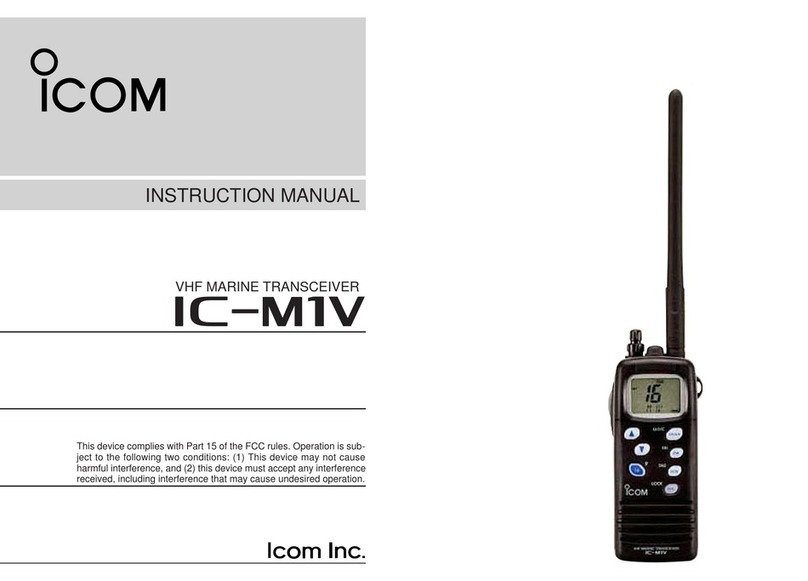
Icom
Icom IC-M1V User manual
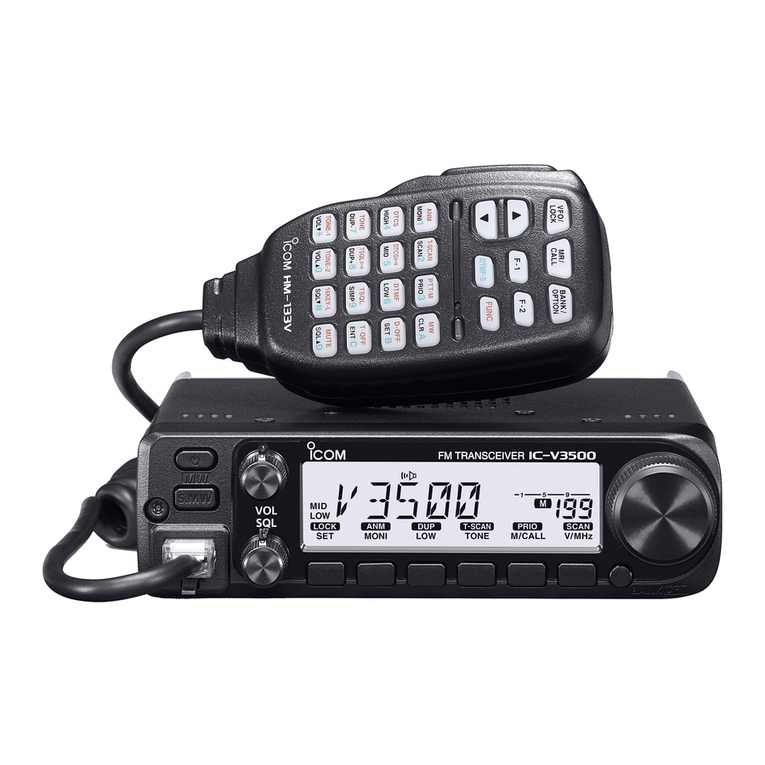
Icom
Icom IC-V3500 User manual
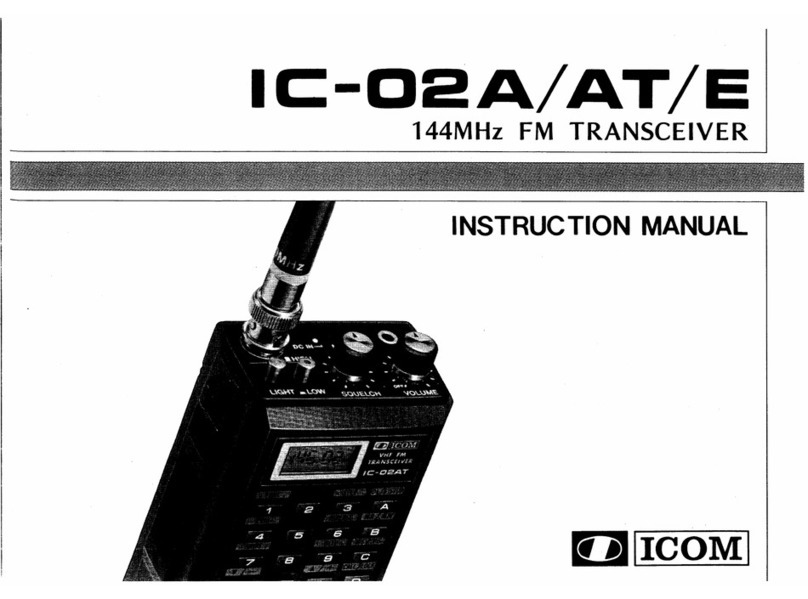
Icom
Icom IC-02A User manual
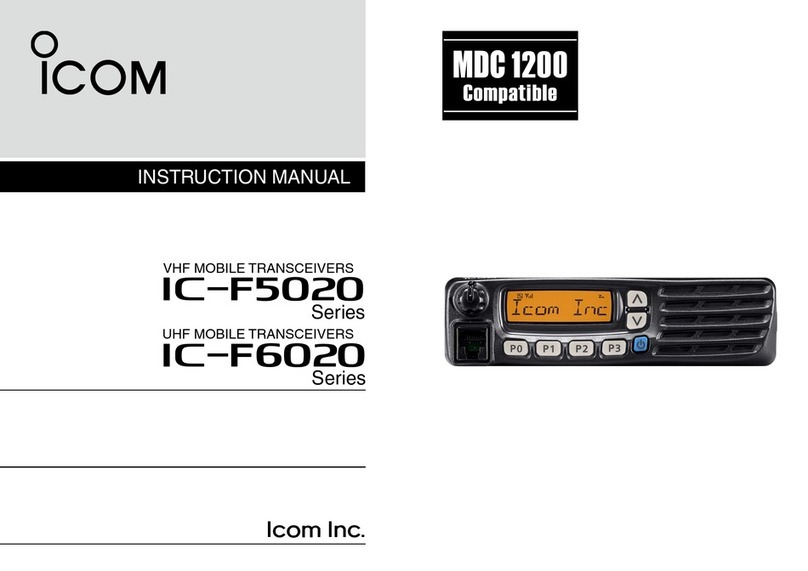
Icom
Icom IC-F5020 Series User manual
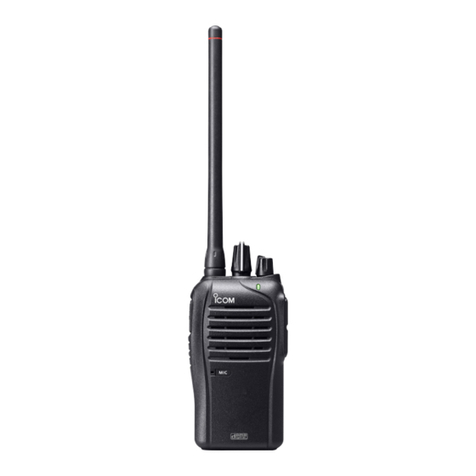
Icom
Icom iDAS IC-F3103D User manual
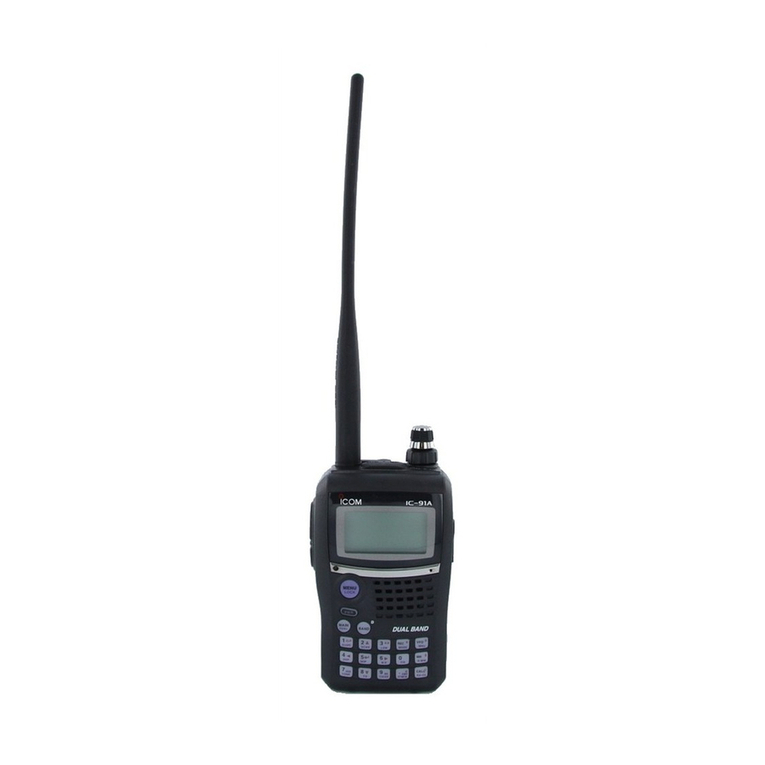
Icom
Icom IC-91A User manual
